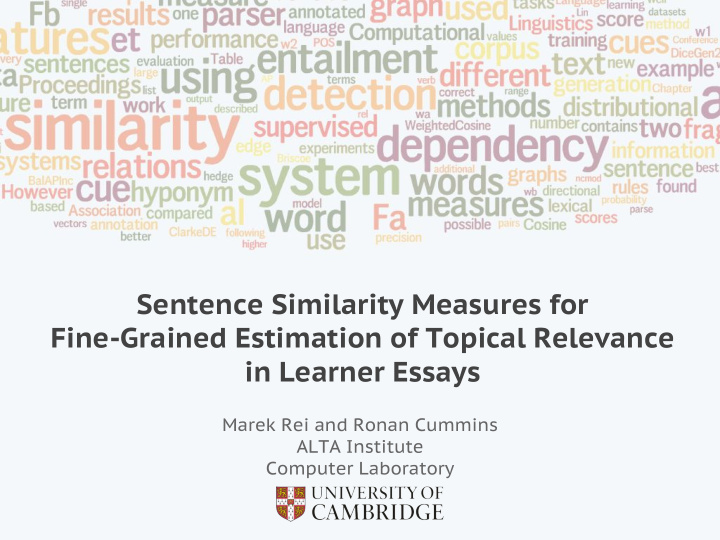



Sentence Similarity Measures for Fine-Grained Estimation of Topical Relevance in Learner Essays Marek Rei and Ronan Cummins ALTA Institute Computer Laboratory
Detecting the topical relevance of learner essays Motivation for topic relevance detection: ● Detect unsuitable topic shifts ● Detect memorised responses Can train a topic-specific classifier to detect relevant texts. score ∈ [0, 1] document f but we need a training set for each topic. Can construct a topic-independent scoring function to detect relevance between the topic and the text. document score ∈ [0, 1] f topic can use it on previously unseen topics.
Sentence-level topic relevance ● Able to provide more fine-grained feedback. ● Can be used for estimating the coherence of an essay. ● Can be used as a feature for sentence quality estimation (Andersen et al., 2013).
TF-IDF (Sparck Jones, 1972) We can map sentences and prompts to vectors and measure their cosine similarity. TF-IDF over words to construct vector representations for the topic and the target sentence. Assigns low weights to frequent words (determiners, prepositions, etc). Assigns high weights to rare words (often spcecific content words). Word frequency statistics collected from 100M words in the BNC.
Word2vec (CBOW, Mikolov et al, 2015) ● Learns distributed vector representations. ● Trains the vectors of the context words to predict the target word. ● To create a sentence vector, we add together the vectors for all the words in that sentence. ● We use the publicly available vectors, trained on 100B words of news text.
IDF-Embeddings Hypothesis: we can improve this additive model by individually weighting each word. Let’s scale each word embedding with the IDF weight of the corresponding word. Retains the direction of each embedding. But more frequent words now have lower impact on the sum.
Skip-Thoughts (Kiros et al., 2015) A sentence is mapped to a vector using a recurrent network. The model is trained to predict words in the surrounding sentences, conditioned on that sentence vector. Trained on 985M words from unpublished books.
Weighted-Embeddings Scale word embeddings with a weight, which we learn automatically from data. 1. Pick a main sentence u 2. Pick a nearby sentence v (which is likely to be related to u) 3. Pick a random sentence z 4. Construct sentence vectors by summing weighted word embeddings 5. Optimise the word weights g w so that u and v are similar, and u and z are dissimilar.
Evaluation Using two publicly available corpora of learner essays: 1. First Certificate in English (FCE, Yannakoudakis et al. 2011) 30,899 sentences and 60 prompts Detailed prompts, describing a scenario or giving instructions on what to mention in the text. Average prompt has 10.3 sentences. 2. International Corpus of Learner English (ICLE, Granger et al. 2009) 20,883 sentences and 13 prompts. Short and general prompts, designed to point the student towards an open discussion around a topic. Average prompt has 1.5 sentences. The system is presented with each sentence independently and it aims to correctly identify the prompt that the student was following.
Results: accuracy
Example output Most University degrees are theoretical and do not prepare us for the real life. Do you agree or disagree? Students have to study subjects which are not closely related to the 0.382 subject they want to specialize in. In order for that to happen however, our government has to offer 0.329 more and more jobs for students. I thought the time had stopped and the day on which the results had 0.085 to be announced never came. Most relevant words for this prompt: University, degrees, undergraduate, doctorate, professors, university, degree, professor, PhD, College, psychology
Example weights cos 3.32 two -1.31 studio 2.22 although -1.26 Labour 2.18 which -1.09 want 2.01 five -1.06 US 2.00 during -0.80 Secretary 1.99 the -0.73 Ref 1.98 unless -0.66 film 1.98 since -0.66 v. 1.91 when -0.66 Cup 1.89 also -0.65 data 1.88 being -0.63 drink 1.88 high -0.62 Minister 1.87 especially -0.62 IBM 1.86 their -0.62 Act 1.86 making -0.61
Conclusion ● We can measure topic relevance of learner essays at the sentence level, using an unsupervised similarity function. ● TF-IDF is the best measure when the prompts are highly detailed. ● Embeddings-based methods are best when the prompts are short and general. ● We can improve embedding-based vectors by learning the individual weights for each word. ● By optimising the model for sentence similarity, the weights learn to assign higher importance to topic-specific words.
Thank you!
Recommend
More recommend